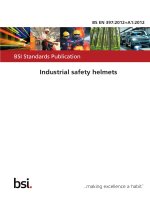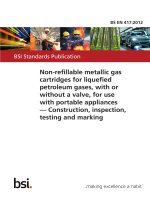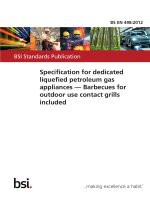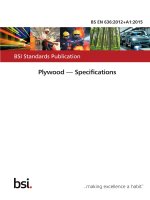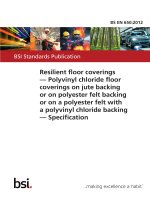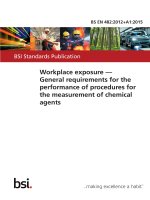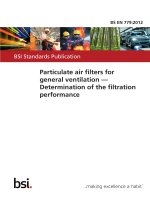Bsi bs en 61701 2012
Bạn đang xem bản rút gọn của tài liệu. Xem và tải ngay bản đầy đủ của tài liệu tại đây (1.08 MB, 18 trang )
BS EN 61701:2012
BSI Standards Publication
Salt mist corrosion testing of
photovoltaic (PV) modules
BRITISH STANDARD
BS EN 61701:2012
National foreword
This British Standard is the UK implementation of EN 61701:2012. It is
identical to IEC 61701:2011. It supersedes BS EN 61701:2000 which is withdrawn.
The UK participation in its preparation was entrusted to Technical Committee
GEL/82, Photovoltaic Energy Systems.
A list of organizations represented on this committee can be obtained on
request to its secretary.
This publication does not purport to include all the necessary provisions of a
contract. Users are responsible for its correct application.
© The British Standards Institution 2012
Published by BSI Standards Limited 2012
ISBN 978 0 580 69180 5
ICS 27.160
Compliance with a British Standard cannot confer immunity from
legal obligations.
This British Standard was published under the authority of the Standards
Policy and Strategy Committee on 30 April 2012.
Amendments issued since publication
Amd. No.
Date
Text affected
BS EN 61701:2012
EUROPEAN STANDARD
EN 61701
NORME EUROPÉENNE
March 2012
EUROPÄISCHE NORM
ICS 27.160
Supersedes EN 61701:1999
English version
Salt mist corrosion testing of photovoltaic (PV) modules
(IEC 61701:2011)
Essai de corrosion au brouillard salin des
modules photovoltaïques (PV)
(CEI 61701:2011)
Salznebel-Korrosionsprüfung von
photovoltaischen (PV-)Modulen
(IEC 61701:2011)
This European Standard was approved by CENELEC on 2012-01-19. CENELEC members are bound to comply
with the CEN/CENELEC Internal Regulations which stipulate the conditions for giving this European Standard
the status of a national standard without any alteration.
Up-to-date lists and bibliographical references concerning such national standards may be obtained on
application to the CEN-CENELEC Management Centre or to any CENELEC member.
This European Standard exists in three official versions (English, French, German). A version in any other
language made by translation under the responsibility of a CENELEC member into its own language and notified
to the CEN-CENELEC Management Centre has the same status as the official versions.
CENELEC members are the national electrotechnical committees of Austria, Belgium, Bulgaria, Croatia, Cyprus,
the Czech Republic, Denmark, Estonia, Finland, France, Germany, Greece, Hungary, Iceland, Ireland, Italy,
Latvia, Lithuania, Luxembourg, Malta, the Netherlands, Norway, Poland, Portugal, Romania, Slovakia, Slovenia,
Spain, Sweden, Switzerland, Turkey and the United Kingdom.
CENELEC
European Committee for Electrotechnical Standardization
Comité Européen de Normalisation Electrotechnique
Europäisches Komitee für Elektrotechnische Normung
Management Centre: Avenue Marnix 17, B - 1000 Brussels
© 2012 CENELEC -
All rights of exploitation in any form and by any means reserved worldwide for CENELEC members.
Ref. No. EN 61701:2012 E
BS EN 61701:2012
EN 61701:2012
-2-
Foreword
The text of document 82/668/FDIS, future edition 2 of IEC 61701, prepared by IEC TC 82, "Solar
photovoltaic energy systems" was submitted to the IEC-CENELEC parallel vote and approved by
CENELEC as EN 61701:2012.
The following dates are fixed:
•
•
latest date by which the document has
to be implemented at national level by
publication of an identical national
standard or by endorsement
latest date by which the national
standards conflicting with the
document have to be withdrawn
(dop)
2012-10-19
(dow)
2015-01-19
This document supersedes EN 61701:1999.
EN 61701:2012 includes the following significant technical changes with respect to EN 61701:1999:
— The scope has been updated to better reflect the applicability of the standard.
— Salt mist test is based on EN 60068-2-52 rather than EN 60068-2-11 as in EN 61701:1999 since
the former standard is much more widely used in the electronic component field. According to this
change EN 61701:2012 includes a cycling testing sequence that combines in each cycle a salt
fog exposure followed by humidity storage under controlled temperature and relative humidity
conditions. This testing sequence is more suitable to reflect the corrosion processes that happen
in PV modules subjected to permanent or temporary corrosive atmospheres (NaCl). In
EN 61701:1999 only a salt fog exposure was considered.
— Additional tests have also been included to verify the effect of the salt mist test not only in the PV
module output but also in some of its components.
— Different testing sequences are considered depending on the PV module technology involved:
crystalline silicon, thin-film and concentrator photovoltaic (CPV) modules.
— A test report clause has also been included.
Attention is drawn to the possibility that some of the elements of this document may be the subject of
patent rights. CENELEC [and/or CEN] shall not be held responsible for identifying any or all such patent
rights.
Endorsement notice
The text of the International Standard IEC 61701:2011 was approved by CENELEC as a European
Standard without any modification.
BS EN 61701:2012
EN 61701:2012
-3-
Annex ZA
(normative)
Normative references to international publications
with their corresponding European publications
The following documents, in whole or in part, are normatively referenced in this document and are
indispensable for its application. For dated references, only the edition cited applies. For undated
references, the latest edition of the referenced document (including any amendments) applies.
NOTE When an international publication has been modified by common modifications, indicated by (mod), the relevant EN/HD
applies.
Publication
Year
Title
EN/HD
Year
IEC 60068-2-52
-
Environmental testing Part 2: Tests - Test Kb: Salt mist, cyclic
(sodium chloride solution)
EN 60068-2-52
-
IEC 61215
2005
Crystalline silicon terrestrial photovoltaic (PV) EN 61215
modules - Design qualification and type
approval
2005
IEC 61646
2008
EN 61646
Thin-film terrestrial photovoltaic
(PV) modules - Design qualification and type
approval
2008
IEC 61730-2 (mod) 2004
Photovoltaic (PV) module safety qualification - EN 61730-2
Part 2: Requirements for construction
2007
IEC 62108
2007
Concentrator Photovoltaic (CPV) modules
and assemblies - Design qualification and
type approval
EN 62108
ISO/IEC 17025
-
General requirements for the competence
of testing and calibration laboratories
EN ISO/IEC 17025 -
2008
–2–
BS EN 61701:2012
61701 © IEC:2011
CONTENTS
1
Scope and object .............................................................................................................. 5
2
Normative references ....................................................................................................... 5
3
Samples ........................................................................................................................... 6
4
Test procedures ............................................................................................................... 6
4.1
4.2
5
General ................................................................................................................... 6
Bypass diode functionality test ................................................................................ 6
4.2.1 Purpose ....................................................................................................... 6
4.2.2 Apparatus .................................................................................................... 6
4.2.3 Procedure .................................................................................................... 7
4.2.4 Requirements .............................................................................................. 7
Preconditioning ................................................................................................................ 7
6
Initial measurements ........................................................................................................ 7
7
Salt mist test procedure .................................................................................................... 8
8
Cleaning and recovery ...................................................................................................... 8
9
Final measurements ......................................................................................................... 9
10 Requirements ................................................................................................................. 10
10.1
10.2
10.3
10.4
11 Test
General ................................................................................................................. 10
Crystalline silicon .................................................................................................. 10
Thin-film technologies ........................................................................................... 10
Concentrator photovoltaic (CPV) modules ............................................................. 10
report...................................................................................................................... 11
Figure 1 – Salt mist corrosion testing sequence for crystalline silicon PV modules ................ 12
Figure 2 – Salt mist corrosion testing sequence for thin-film PV modules .............................. 13
Figure 3 – Salt mist corrosion testing sequence for concentrator photovoltaic (CPV)
modules ................................................................................................................................ 14
BS EN 61701:2012
61701 © IEC:2011
–5–
SALT MIST CORROSION TESTING OF PHOTOVOLTAIC (PV) MODULES
1
Scope and object
Photovoltaic (PV) modules are electrical devices intended for continuous outdoor exposure
during their lifetime. Highly corrosive wet atmospheres, such as marine environments, could
eventually degrade some of the PV module components (corrosion of metallic parts,
deterioration of the properties of some non-metallic materials - such as protective coatings
and plastics - by assimilation of salts, etc.) causing permanent damages that could impair
their functioning. Temporary corrosive atmospheres are also present in places where salt is
used in winter periods to melt ice formations on streets and roads.
This Standard describes test sequences useful to determine the resistance of different PV
modules to corrosion from salt mist containing Cl (NaCl, MgCl 2 , etc.). All tests included in the
sequences, except the bypass diode functionality test, are fully described in IEC 61215,
IEC 61646, IEC 62108, IEC 61730-2 and IEC 60068-2-52. They are combined in this Standard
to provide means to evaluate possible faults caused in PV modules when operating under wet
atmospheres having high concentration of dissolved salt (NaCl). Depending on the specific
nature of the surrounding atmosphere to which the module is exposed in real operation
several testing severities can be applied, as defined in IEC 60068-2-52. For example severity
(1) is intended to be used for PV modules used in a marine environment, or in close proximity
to the sea. Severities (3) to (6) are intended for PV modules operating in locations where
there could be a change between salt-laden and dry atmospheres, for examples in places
where salt is used to melt ice formations. Severity (2) is not suitable for PV modules as
testing conditions are too weak (this severity is originally intended for products exposed to
corrosive environments from time to time that are normally protected by an enclosure) and
should be avoided when applying this Standard.
This Standard can be applied to both flat plate PV modules and concentrator PV modules and
assemblies.
2
Normative references
The following documents, in whole or in part, are normatively referenced in this document and
are indispensable for its application. For dated references, only the edition cited applies. For
undated references, the latest edition of the referenced document (including any
amendments) applies.
IEC 60068-2-52, Environmental testing – Part 2-52: Tests – Test Kb: Salt mist, cyclic (sodium
chloride solution)
IEC 61215:2005, Crystalline silicon
qualification and type approval
terrestrial
photovoltaic
(PV)
modules
–
Design
IEC 61646:2008, Thin-film terrestrial photovoltaic (PV) modules – Design qualification and
type approval
IEC 61730-2:2004, Photovoltaic (PV) module safety qualification – Part 2: Requirements for
testing
IEC 62108:2007, Concentrator photovoltaic (CPV) modules and assemblies – Design
qualification and type approval
–6–
BS EN 61701:2012
61701 © IEC:2011
ISO/IEC 17025, General requirements for the competence of testing and calibration
laboratories
3
Samples
Three identical samples of the model of PV module or assembly of interest shall be subjected
to any of the testing sequences included in Figures 1, 2 or 3, depending on the PV technology
considered, namely crystalline silicon, thin-film or concentrator photovoltaic (CPV)
respectively. As the figures indicate one of these samples should be used as a control. The
control sample should be used as a check every time the test samples are measured to
evaluate the effect of the salt mist test.
In the case of CPV different situations for choosing the sample may occur. For non-fieldadjustable focus-point CPV systems or modules, 3 modules are required to complete the
testing sequence included in Figure 3. For field-adjustable focus-point CPV systems or
assemblies, 3 receivers (including secondary optics sections, if applicable) and 3 primary
optics sections are required to complete the testing sequence included in Figure 3. A
complete description of the different types and components of CPV modules and assemblies
can be found in IEC 62108.
If a full-size sample is too large to fit into the environmental chambers required for the salt
mist test then a smaller representative sample may be specially designed and manufactured
for this test. The representative sample should be carefully designed so that it can reveal
similar failure mechanisms as the full-size one, and the fabrication process of the
representative sample should be as identical as possible to the process of the full-size ones.
The fact that the test has been made on representative samples and not on the full-size
samples has to be indicated and reported in the test report under item g), see Clause 11.
If the PV module is provided with means for grounding then they constitute a part of the test
sample.
4
Test procedures
4.1
General
All tests included in Figures 1, 2 or 3, except the bypass diode functionality test, are fully
described (including purpose, apparatus, procedure and requirements) in the IEC Standards
from where the specific tests are taken (see notes in the Figures). Tests included in Figures
1, 2 or 3 shall be performed in the specified order. In the case of CPV if some test procedures
included in this Standard are not applicable to a specific design configuration, the
manufacturer should discuss this with the testing agency to develop a comparable test
program, based on the principles described in this Standard. Any changes and deviations
shall be recorded and reported in detail, as required in Clause 11, item l).
4.2
4.2.1
Bypass diode functionality test
Purpose
To verify that the bypass diode(s) of the test samples remains functional following the salt fog
exposure.
NOTE If in the test sample there are no bypass diodes or the bypass diodes do not have any metallic parts then
this test is omitted.
4.2.2
Apparatus
a) DC power source capable of applying a current up to 1,25 times the standard test
conditions (STC) short-circuit current of the sample under test and means for monitoring
the flow of current through the test sample during the test period.
BS EN 61701:2012
61701 © IEC:2011
–7–
b) Equipment for measuring the voltage drop across the test sample at an accuracy of
± 0,5 % of reading.
c) Equipment for measuring test current at an accuracy of ± 0,5 % of reading.
4.2.3
Procedure
This procedure can be conducted in any ambient within 25 °C ± 10 °C. During the test the
sample shall not be subjected to illumination.
a) Electrically short any blocking diodes incorporated to the test sample.
b) Determine the rated STC short-circuit current of the test sample from its label or
instruction sheet.
c) Connect the DC power source’s positive output to the test sample negative lead, and the
DC power source’s negative output to the test sample positive lead by using wires of the
manufacturer’s minimum recommended wire gauge. Follow the manufacturer’s
recommendations for wire entry into the wiring compartment. With this configuration the
current shall pass through the cells in the reverse direction and through the diode(s) in the
forward direction.
NOTE Some modules have overlapping bypass diode circuits. In this case it may be necessary to install a jumper
cable to ensure that all of the current is flowing through one bypass diode.
d) Apply a current equal to of 1,25 times (± 5 %) the STC short-circuit current of the test
sample for a period of 1 h.
4.2.4
Requirements
After the 1 h of current flow check that the bypass diode(s) remains operational. A possible
method is to again pass a forward current through the diode(s) by passing a reverse current
through the cells and then monitor the temperature of the diode(s) with the aid of a thermal IR
camera. Diode(s) shall reach thermal equilibrium with the environment after step d) above
before applying this procedure. Another option is to shade a solar cell protected by each
diode (one per string, step by step) in the PV module and verify the characteristics of the
resulting I-V curve (under illumination close to STC) to check if the bypass diode(s) is(are)
working.
5
Preconditioning
All test samples shall be preconditioned with either global or direct normal sunlight (natural or
simulated) according to the specifications given in the applicable design qualification and type
approval IEC Standard applicable to the PV module technology considered, i.e., IEC 61215
for crystalline silicon, IEC 61646 for thin-film materials and IEC 62108 for concentrator
photovoltaic (CPV). At the time of writing this Standard no preconditioning is specified for
thin-film technologies in IEC 61646.
6
Initial measurements
6.1 The following initial measurements shall be performed on the selected samples
depending on the PV module technology being evaluated.
6.2
–
Crystalline silicon. The test order is included in Figure 1.
Tests according to IEC 61215:
a) 10.2: Maximum power determination
b) 10.15: Wet leakage current test
–
Tests according to IEC 61730-2
c) MST 01: Visual inspection
–8–
BS EN 61701:2012
61701 © IEC:2011
d) MST 13: Ground continuity test
e) MST 16: Dielectric withstand test
NOTE
6.3
–
The reference before each test corresponds to its identification in the relevant IEC Standard.
Thin-film technologies. The test order is included in Figure 2.
Tests according to IEC 61646:
a) 10.2: Maximum power determination.
NOTE 1 The only purpose of this test is to verify that the PV module is operational before being subjected to the
subsequent tests of the sequence.
b) 10.15: Wet leakage current test
–
Tests according to IEC 61730-2
c) MST 01: Visual inspection
d) MST 13: Ground continuity test
e) MST 16: Dielectric withstand test
NOTE 2
6.4
–
The reference before each test corresponds to its identification in the relevant IEC Standard.
Concentrator photovoltaic (CPV) modules. The test order is included in Figure 3.
Tests according to IEC 62108:
a) 10.1: Visual inspection
b) 10.2: Electrical performance measurement
c) 10.3: Ground path continuity test
d) 10.4: Electrical insulation test
e) 10.5: Wet insulation test
NOTE
7
The reference before each test correspond to its identification in IEC 62108.
Salt mist test procedure
Apply to the test samples under study the salt mist test as described in IEC 60068-2-52
following the general conditions, apparatus, characteristics of the salt solution, severities and
other specifications included. The severity of the salt mist test shall be chosen according to
the atmospheric conditions prevailing in the place where the installation of the PV modules is
intended. Severity (2) is not suitable for PV modules as testing conditions are too weak (it is
intended for products exposed to corrosive environments from time to time that are normally
protected by an enclosure) and should be avoided when applying this Standard. During
testing the face of the PV module normally exposed to solar irradiance shall be inclined 15° to
30° from vertical inside the salt fog chamber. The module can be placed vertically in the
humidity chamber used for the humidity storage portion of the test.
8
Cleaning and recovery
After the salt mist test all samples shall be washed to remove the adherent salt using running
tap water (not artificially pressurised) for a maximum time of 5 min per square metre of area
of the sample. Once the washing is finished distilled or demineralized water shall be used to
rinse the samples, followed by complete drying at room temperature. To accelerate drying it is
allowed to shake the test sample by hand or to use air blasts with the aid of a fan. The
temperature of the water used for washing shall not exceed 35 °C. During cleaning or drying
the use of cloths, gauzes or any other woven material shall be avoided and no scraping is
allowed. After drying, the recovery time shall be minimised and the applicable testing
sequence shall be continued as soon as possible to avoid further damage produced by salt
depositions.
BS EN 61701:2012
61701 © IEC:2011
9
–9–
Final measurements
9.1 After the salt mist test the test samples shall be subjected to the following tests
depending on the PV module technology.
9.2
–
Crystalline silicon. The test order is included in Figure 1.
Tests according to IEC 61215:
a) 10.2: Maximum power determination
b) 10.15: Wet leakage current test
–
Tests according to IEC 61730-2:
c) MST 01: Visual inspection
d) MST 13: Ground continuity test
e) MST 16: Dielectric withstand test
NOTE
–
Test according to this Standard:
f)
9.3
–
The reference before each test corresponds to its identification in the relevant IEC Standard.
Bypass diode functionality test
Thin-film technologies. The test order is included in Figure 2.
Tests according to IEC 61646:
a) 10.6: Performance at STC (not NOCT)
b) 10.15: Wet leakage current test
c) 10.19: Light soaking
–
Tests according to IEC 61730-2
d) MST 01: Visual inspection
e) MST 13: Ground continuity test
f)
NOTE
–
MST 16: Dielectric withstand test
The reference before each test corresponds to its identification in the relevant IEC Standard.
Test according to this Standard:
g) Bypass diode functionality test
9.4
–
Concentrator photovoltaic (CPV) module. The test order is included in Figure 3.
Tests according to IEC 62108:
a) 10.1: Visual inspection
b) 10.2: Electrical performance measurement
c) 10.3: Ground path continuity test
d) 10.4: Electrical insulation test
e) 10.5: Wet insulation test
NOTE
–
The reference before each test corresponds to its identification in IEC 62108.
Test according to this Standard:
f) Bypass diode functionality test
– 10 –
BS EN 61701:2012
61701 © IEC:2011
10 Requirements
10.1
General
The following requirements shall be fulfilled by the two PV samples that undergo the testing
sequences included in Figures 1, 2 or 3:
10.2
Crystalline silicon
–
After the salt mist test there shall be no evidence of major visual defects as described in
IEC 61730-2 including also no mechanical deterioration or corrosion of module
components which would significantly impair their function during their intended life.
–
After the salt mist test the maximum power shall not decrease by more than 5 % of the
initial value.
NOTE
The pass/fail criteria should consider the laboratory uncertainty of measurement.
–
All pass fail criteria corresponding to tests 10.15, MST 13 and MST 16 shall be fulfilled
according to what is specified in IEC 61215 and IEC 61730-2 for these specific tests.
–
The requirement for the bypass diode functionality test shall be also fulfilled.
10.3
Thin-film technologies
–
After the salt mist test there shall be no evidence of major visual defects as described in
IEC 61730-2 including also no mechanical deterioration or corrosion of module
components which would significantly impair their function during their intended life.
–
After the light soaking the maximum power at Standard Test Conditions (STC) shall not be
less than 90 % of the minimum value specified by the manufacturer in the marking of the
PV module.
NOTE 1
–
The pass/fail criteria should consider the laboratory uncertainty of measurement.
All pass fail criteria corresponding to tests 10.15, 10.19, MST 13 and MST 16 shall be
fulfilled according to what is specified in IEC 61646 and IEC 61730-2 for these specific
tests.
NOTE 2 In the case of the requirements corresponding to test 10.19 (light soaking) MST 01 of IEC 61730-2
should be applied instead of test 10.1 of IEC 61646 and MST 16 of IEC 61730-2 should be applied instead of test
10.3 of IEC 61646.
–
The requirement for the bypass diode functionality test shall be also fulfilled.
10.4
Concentrator photovoltaic (CPV) modules
–
After the salt mist test there shall be no evidence of major visual defects as described in
IEC 62108 including also no mechanical deterioration or corrosion of test sample
components which would significantly impair their function during their intended life. No
significant amount of water should remain inside the test sample after the salt mist test
(the depth of the remaining water should not reach any electrically active parts in any
possible position).
–
After the salt mist test the relative power degradation shall not exceed 7 % if the I-V
measurement is under outdoor natural sunlight, or 5 % if the I-V measurement is under
solar simulator.
NOTE
The pass/fail criteria should consider the laboratory uncertainty of measurement.
–
All pass fail criteria corresponding to tests 10.3, 10.4 and 10.5 shall be fulfilled according
to what is specified in IEC 62108 for these specific tests.
–
The requirement for the bypass diode functionality test shall be also fulfilled.
BS EN 61701:2012
61701 © IEC:2011
– 11 –
11 Test report
A test report with measured performance characteristics and test results shall be prepared by
the test agency in accordance with ISO/IEC 17025. The test report shall contain the following
data:
a) a title;
b) name and address of the test laboratory and location where the tests were carried out;
c) unique identification of the certification or report and of each page, and a clear
identification of the purpose of the test report;
d) name and address of client, where appropriate;
e) reference to sampling procedure, where relevant;
f)
date of receipt of test items and date(s) of test, where appropriate;
g) description and identification of the items tested. If the test has been made on
representative samples and not on the full-size samples this has to be clearly indicated;
h) characterization and condition of the test items;
i)
identification of test method used;
j)
characteristics of the salt solution used;
k) severity applied for the salt mist test according to IEC 60068-2-52;
l)
any deviations from, additions to or exclusions from the test method, and any other
information relevant to a specific test, such as environmental conditions;
m) measurements, examinations and derived results supported by tables, graphs, sketches
and photographs as appropriate including any failures observed;
n) a statement of the estimated uncertainty of the test results (where relevant);
o) a signature and title, or equivalent identification of the person(s) accepting responsibility
for the content of the certificate or report, and the date of issue;
p) where relevant, a statement to the effect that the results relate only to the items tested;
q) a statement that the report shall not be reproduced except in full, without the written
approval of the laboratory.
A copy of this report shall be kept by the laboratory and manufacturer for reference purposes.
BS EN 61701:2012
61701 © IEC:2011
– 12 –
3 modules
Preconditioning
MST 01
Visual inspection
10.2
Maximum power determination
MST 16
Dielectric withstand test
10.15
Wet leakage current test
MST 13
Ground continuity test
2 modules
1 module
Salt mist test according to any one of the severities included in IEC 60068-2-52, except severity 2
Cleaning and recovery
MST 01
Visual inspection
10.2
Maximum power determination
C
o
n
t
r
o
l
MST 16
Dielectric withstand test
10.15
Wet leakage current test
MST 13
Ground continuity test
Bypass diode functionality test
IEC
2751/11
NOTE 1 Preconditioning and tests 10.2 and 10.15 are taken from IEC 61215. Tests MST 01, MST 13 and MST 16 are taken
from IEC 61730-2.
NOTE 2 The control module should be used as a check every time the test modules are measured to evaluate the effect of
the salt mist test.
Figure 1 – Salt mist corrosion testing sequence for crystalline silicon PV modules
BS EN 61701:2012
61701 © IEC:2011
– 13 –
3 modules
MST 01
Visual inpection
10.2
Maximum power determination
MST 16
Dielectric withstand test
10.15
Wet leakage current test
MST 13
Ground continuity test
2 modules
1 module
Salt mist test according to any one of the severities included in IEC 60068-2-52, except severity 2
Cleaning and recovery
MST 01
Visual inspection
MST 16
Dielectric withstand test
C
o
n
t
r
o
l
10.15
Wet leakage current test
MST 13
Ground continuity test
Bypass diode functionality test
10.19
Light soaking
10.6
Performance at STC (not NOCT)
IEC
2752/11
NOTE 1 Tests 10.2, 10.6, 10.15 and 10.19 are taken from IEC 61646. Tests MST 01, MST 13 and MST 16 are taken from
IEC 61730-2.
NOTE 2 The control module should be used as check every time the test modules are measured to evaluate the effect of
the salt mist test.
NOTE 3 Maximum power determination after salt mist test according to test 10.2 of IEC 61646 could eventually be made
for diagnostic purpose only.
NOTE 4 Test 10.6 is performed as a part of the requirements corresponding to test 10.19 a described in IEC 61646. For
the remaining requirements use test MST 01 instead of 10.1 and MST 16 instead of 10.3.
Figure 2 – Salt mist corrosion testing sequence for thin-film PV modules
BS EN 61701:2012
61701 © IEC:2011
– 14 –
3 modules (m) (for CPV modules)
3 receivers (r) + 3 mirrors (mir) (for CPV assemblies)
Preconditioning
10.1
Visual inspection
3m
3r + 3mir
10.2
Electrical performance measurement
10.4
Electrical insulation test
3m
3r + 3mir
3m
3r + 3mir
10.5
Wet insulation test
3m
3r + 3mir
10.3
Ground path continuity test
1m (for CPV modules)
1r + 1mir (for CPV assemblies)
3m
3r + 3mir
2m (for CPV modules)
2r + 2mir (for CPV assemblies)
Salt mist test according to any one of the severities included in IEC 60068-2-52, except severity 2
2m
2r + 2mir
Cleaning and recovery
10.1
Visual inspection
2m
2r + 2mir
10.2
Electrical performance measurement
C
o
n
t
r
o
l
10.4
Electrical insulation test
10.5
Wet insulation test
2m
2r + 2mir
2m
2r + 2mir
2m
2r + 2mir
10.3
Ground path continuity test
Bypass diode functionality test
2m
2r + 2mir
2m
2r
IEC
2753/11
NOTE 1
Tests 10.1, 10.2, 10.3, 10.4 and 10.5 are taken from IEC 62108.
NOTE 2
The control sample should be used as a check every time the test sample are measured to evaluate the effect
of the salt mist test.
Figure 3 – Salt mist corrosion testing sequence
for concentrator photovoltaic (CPV) modules
____________
This page deliberately left blank
NO COPYING WITHOUT BSI PERMISSION EXCEPT AS PERMITTED BY COPYRIGHT LAW
British Standards Institution (BSI)
BSI is the national body responsible for preparing British Standards and other
standards-related publications, information and services.
BSI is incorporated by Royal Charter. British Standards and other standardization
products are published by BSI Standards Limited.
About us
Revisions
We bring together business, industry, government, consumers, innovators
and others to shape their combined experience and expertise into standards
-based solutions.
Our British Standards and other publications are updated by amendment or revision.
The knowledge embodied in our standards has been carefully assembled in
a dependable format and refined through our open consultation process.
Organizations of all sizes and across all sectors choose standards to help
them achieve their goals.
Information on standards
We can provide you with the knowledge that your organization needs
to succeed. Find out more about British Standards by visiting our website at
bsigroup.com/standards or contacting our Customer Services team or
Knowledge Centre.
Buying standards
You can buy and download PDF versions of BSI publications, including British
and adopted European and international standards, through our website at
bsigroup.com/shop, where hard copies can also be purchased.
If you need international and foreign standards from other Standards Development
Organizations, hard copies can be ordered from our Customer Services team.
Subscriptions
Our range of subscription services are designed to make using standards
easier for you. For further information on our subscription products go to
bsigroup.com/subscriptions.
With British Standards Online (BSOL) you’ll have instant access to over 55,000
British and adopted European and international standards from your desktop.
It’s available 24/7 and is refreshed daily so you’ll always be up to date.
You can keep in touch with standards developments and receive substantial
discounts on the purchase price of standards, both in single copy and subscription
format, by becoming a BSI Subscribing Member.
PLUS is an updating service exclusive to BSI Subscribing Members. You will
automatically receive the latest hard copy of your standards when they’re
revised or replaced.
To find out more about becoming a BSI Subscribing Member and the benefits
of membership, please visit bsigroup.com/shop.
With a Multi-User Network Licence (MUNL) you are able to host standards
publications on your intranet. Licences can cover as few or as many users as you
wish. With updates supplied as soon as they’re available, you can be sure your
documentation is current. For further information, email
BSI Group Headquarters
389 Chiswick High Road London W4 4AL UK
We continually improve the quality of our products and services to benefit your
business. If you find an inaccuracy or ambiguity within a British Standard or other
BSI publication please inform the Knowledge Centre.
Copyright
All the data, software and documentation set out in all British Standards and
other BSI publications are the property of and copyrighted by BSI, or some person
or entity that owns copyright in the information used (such as the international
standardization bodies) and has formally licensed such information to BSI for
commercial publication and use. Except as permitted under the Copyright, Designs
and Patents Act 1988 no extract may be reproduced, stored in a retrieval system
or transmitted in any form or by any means – electronic, photocopying, recording
or otherwise – without prior written permission from BSI. Details and advice can
be obtained from the Copyright & Licensing Department.
Useful Contacts:
Customer Services
Tel: +44 845 086 9001
Email (orders):
Email (enquiries):
Subscriptions
Tel: +44 845 086 9001
Email:
Knowledge Centre
Tel: +44 20 8996 7004
Email:
Copyright & Licensing
Tel: +44 20 8996 7070
Email:
